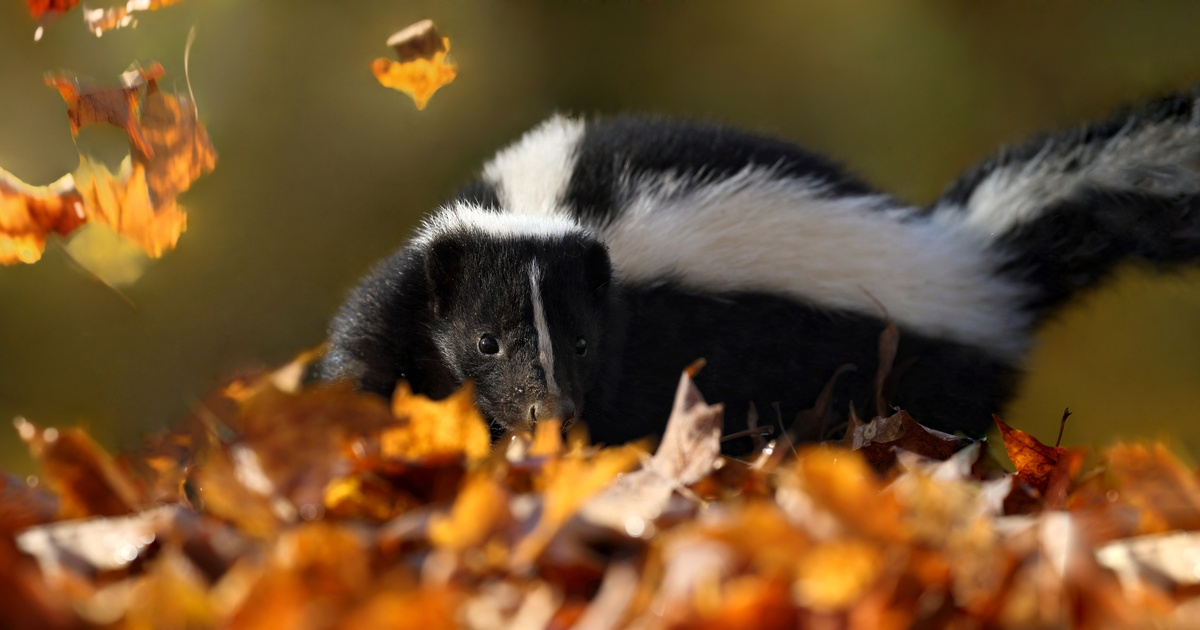

You’re hiking on a peaceful trail when suddenly you spot a small, black and white creature ahead. Your heart skips a beat as you realize it’s a skunk. Don’t panic! While encountering a skunk in the wild feels intimidating, these fascinating animals rarely spray unless they feel threatened or cornered.
Skunks inhabit forests, grasslands, and suburban areas across North America. These nocturnal creatures prefer to avoid humans and will typically waddle away when they sense your presence. However, knowing how to respond during an unexpected encounter can save you from an unpleasant experience and protect you and the wildlife.
Skunks display distinctive physical characteristics that make them easy to recognize. Most North American skunks feature black fur with white stripes running from their head to their tail, though stripe patterns vary by species. They measure the size of a house cat and weigh between 4 to 14 pounds, with short legs and bushy tails.
These animals move with a distinctive waddle due to their body structure. Skunks have excellent hearing and smell but poor eyesight, which explains why they sometimes appear unaware of nearby humans. You might notice them shuffling through leaves or digging in the ground as they search for insects, grubs, and other small animals.
Skunks exhibit predictable defensive behaviors that serve as warning signals before they resort to spraying. When threatened, a skunk will first arch its back, raise its tail, and stomp its front feet. This display gives you clear warning that the animal feels uncomfortable with your presence.
If these initial warnings don’t work, skunks may charge forward a few steps while maintaining their defensive posture. They can spray relatively accurately up to 10 feet and will aim for your face, if possible. However, skunks prefer to conserve their spray since they can only produce a limited amount and need time to replenish their supply.
Your immediate reaction determines the outcome of a skunk encounter. Remain perfectly still when you first spot a skunk, as sudden movements trigger their defensive instincts. Take deep breaths and resist the urge to run, which could cause the animal to perceive you as a threat.
Speak in soft, gentle tones if you need to communicate with others nearby. Skunks respond to the tone and volume of sounds rather than words themselves. Keep your voice low and reassuring, similar to how you might calm a nervous pet.
Direct eye contact signals aggression in the animal kingdom, and skunks interpret sustained stares as threatening behavior. Instead, keep the skunk in your peripheral vision while looking slightly to one side. This allows you to monitor the animal’s movements without appearing confrontational.
Watch for warning signs like tail raising, back arching, or foot stamping. These behaviors indicate increasing stress levels and suggest you should increase your distance immediately.
Back away slowly and smoothly, maintaining your sideways orientation to appear less threatening. Take small, deliberate steps rather than large strides that might startle the animal. Keep your movements fluid and predictable.
Create at least 20 feet of distance between yourself and the skunk before turning around completely. This buffer zone gives you and the animal enough space to feel comfortable while allowing the skunk multiple escape routes.
Position yourself behind trees, large rocks, or other natural barriers when possible. These obstacles provide psychological comfort and can block spray if the situation escalates unexpectedly.
If you’re in an open area without natural barriers, slowly move toward the nearest cover while maintaining your calm demeanor. Avoid ducking behind barriers suddenly, as quick movements defeat the purpose of creating distance safely.
Several common mistakes can transform a peaceful encounter into an unpleasant situation:
These actions increase stress levels and may trigger defensive spraying. Remember that wild skunks can carry diseases like rabies, making physical contact dangerous for additional reasons beyond getting sprayed.
Property owners often worry about skunk damage and odor control when these animals take up residence nearby. Skunks dig small holes while foraging for grubs and insects, which can damage lawns and gardens. They may also den under porches, sheds, or decks during breeding season.
Several natural repellents can discourage skunks from settling on your property. Citrus peels, ammonia-soaked rags, and commercial predator urine create scents that skunks find unpleasant. Apply these deterrents around potential den sites and feeding areas.
Physical barriers work effectively for long-term prevention. Install hardware cloth or chicken wire around deck foundations, garden beds, and compost areas. Make sure barriers extend at least six inches underground to prevent digging underneath.
If a skunk sprays you despite your precautions, act quickly to minimize odor penetration. Remove contaminated clothing immediately and avoid touching sensitive areas like your face or eyes. Rinse your eyes with clean water if the spray makes contact.
Stay outdoors when possible to prevent spreading the odor indoors. The scent intensifies in enclosed spaces and can linger for weeks without proper treatment.
Create a homemade deodorizing solution: a full quart of three percent hydrogen peroxide, one-quarter cup of baking soda, and one teaspoon of your preferred liquid dish soap. Mix these ingredients just before use and apply to the affected skin and hair, avoiding your eyes and mouth.
Rinse thoroughly after 5 to 10 minutes and repeat if necessary. This solution breaks down the sulfur compounds responsible for skunk odor more effectively than traditional remedies like tomato juice or vinegar.
Skunk encounters remind us that we share our outdoor spaces with remarkable wildlife neighbors. These animals play important ecological roles by controlling insect populations and aerating soil through their foraging activities.
By responding calmly and respectfully during a wild skunk encounter, you contribute to positive human-wildlife relationships while protecting yourself from unpleasant experiences. Remember that skunks prefer to avoid confrontation just as much as you do, making most encounters completely manageable with proper knowledge and techniques.

Put your business in front of thousands of LOCALS! Create your free listing on the NewsSTAND and update your profile anytime to share the latest info, specials, and contact details.

Got a story to Share? Pitch your idea or write an article for the NewsSTAND! Join us in highlighting the positive and powerful moments that make our city shine.

We’re passionate about working together to amplify our City. Reach out to the NewsSTAND team to explore collaboration opportunities and make a difference in our community.
Hover over each card to unlock the full story and see what you’re about to get!







